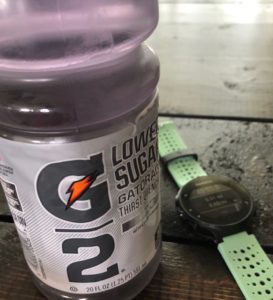“Run strong, run smart, run safe.”
June happens to be a month with a few important running dates.
June 3 is Global Running Day.
June 25 is Gabe Grunewald’s birthday, June 11 is when she died – I include the latter, too because I believe both days are wonderful reasons to celebrate her memory and positivity with a run.
And, as the official start of summer, June is also when we get our longest day of the year, plus the early morning and late evening daylight just lends itself to more running and feeling safer while being out.
Speaking of safer, June is also National Safety Month. What a perfect time to share a few thoughts and ideas for safe running.
For everyone running this summer, whether veteran or newbie to the sport, I wish you miles of healthy, happy, and safe running! Here are 5 tips for safe running, especially now in the summer.
1. Skip the Headphones
This is probably my top safety tip and it’s also just a good all-around practice to reap the stress-relieving, mindfulness benefits of running.

Sunnies out, summer running time.
Forgoing headphones brings several safety benefits. First, it creates opportunity for greater awareness, overall. Oncoming traffic, wildlife or dogs on the loose, even – hopefully this never happens to most but it does happen – sensing and hearing a potential attacker coming up behind you before it happens.
While awareness is the biggest safety factor that comes from running without headphones, there’s also an argument that can be made for better self-pacing. Think about when a really upbeat song or one of your favorites comes on the playlist – you might start running faster, right? If you’re training for speed, this would be a benefit, however, for most people, keeping a comfortable pace for the most part is important to prevent overdoing it or throwing off your stride in a way that risks injury.
2. Plan an Intentional Route
I love quiet, secluded paths but running them does come with some risk, especially really early or late at night. Be smart about the route you choose, forgoing super high-traffic areas and instead saving those more out-of-the-way trails for busier daytime hours, then opting for busier, well-lit areas when the sun is just coming up or dusk is approaching.
For many runners, planning a route isn’t usually necessary, as there are a handful of regular ones that meet various distances. However, if this is you, it’s not a bad idea to switch up your route often. There have been instances where bad people watch and get to know a runner’s route, only to be able to attack in the most vulnerable moment. Again, I hope this never happens to any of us but it does happen.
3. Let Someone Know You’re Going
Ideally, anytime you head out for a solo run, someone knows you’re out there and when to expect you back. In the event something bad happens, the sooner someone is aware, the better the chance there is that help will arrive quickly enough.
I’m in a situation where my spouse always knows when I’m going for a run, whether it’s during the day and we’re simply checking in on how the other is doing, in the morning where he needs to be home in case our son wakes up, or especially if it’s a weekend long run and I’m going to be away for awhile.
For those who don’t have a “reason” to check in with someone else, don’t hesitate to text a friend or family member just to let them know your plans, then again when you arrive home safely. Better safe than sorry.
4. Bring Your Phone
I slightly cringe when sharing this tip, as I love the disconnected, “me” time that running allows. But when talking safety, it really is smart to bring along the phone on a run.

Post-run goodness.
Whether you roll an ankle, are attacked by an animal or person, or even find yourself off your route and lost, having a connection to someone who can help is an important safety measure to take on every run.
5. Hydrate – Then Hydrate More
While hydration is crucial year-round for runners, this is one tip that’s especially important during the summer months. That summer heat, while loved by most who prefer a tank top and shorts to layers on layers of attire, can be tough on the body. Dehydration is a serious health risk so, along with running always must come hydration.
This isn’t to say you have to bring water and drink throughout every run. But, depending on your body and needs, you may need it if you’re running more than a 10k, or 10 miles, or a half marathon.
Whether or not you need the fluids during your run, be sure to take in plenty after your run and throughout the rest of the day. If you’re looking for help to make a habit of drinking more water, last week’s post offers a few ideas.
For those of you who are taking the plunge and taking up running this summer, check out my 7 tips for how to start running.
What other safe running tips can you share? Any experiences you’ve had that have opened your eyes or made you more aware to how you can stay safe while running?
The comments are all yours so please leave one.
Connect with me @lindsayinreallife on Instagram or @LindsayIRL on Twitter. Subscribe to Wellness in Real Life so you get every new blog post straight to your inbox.
